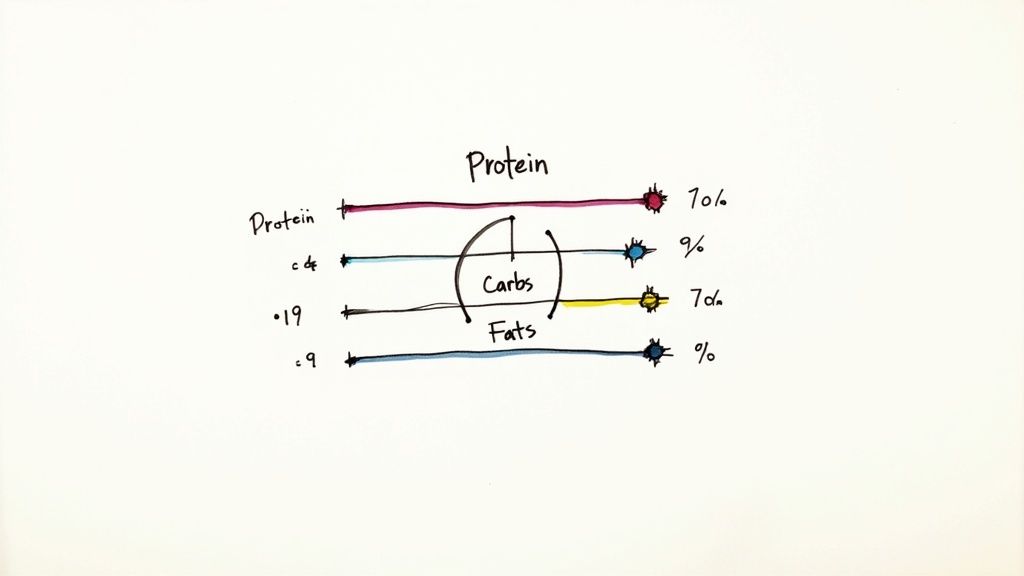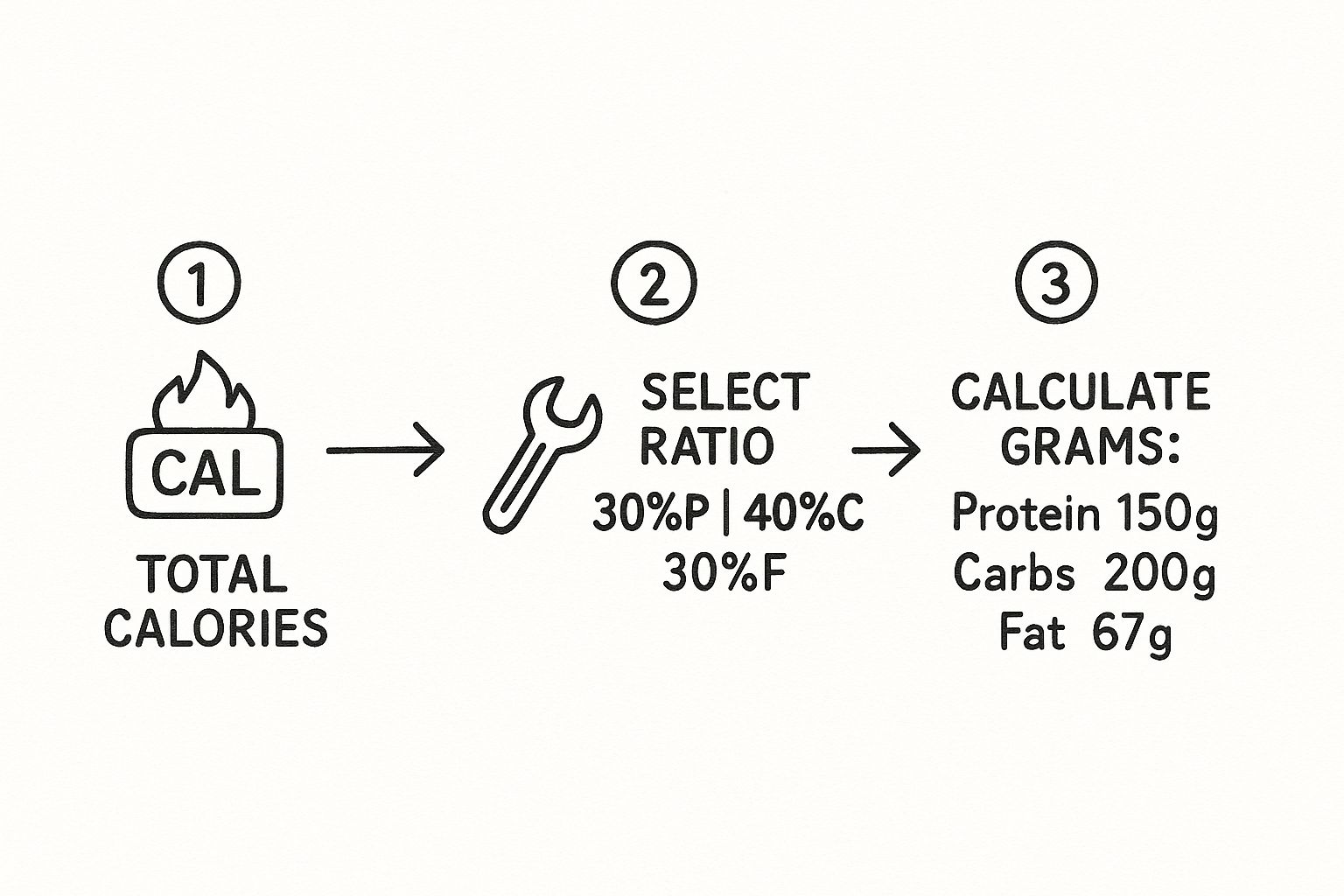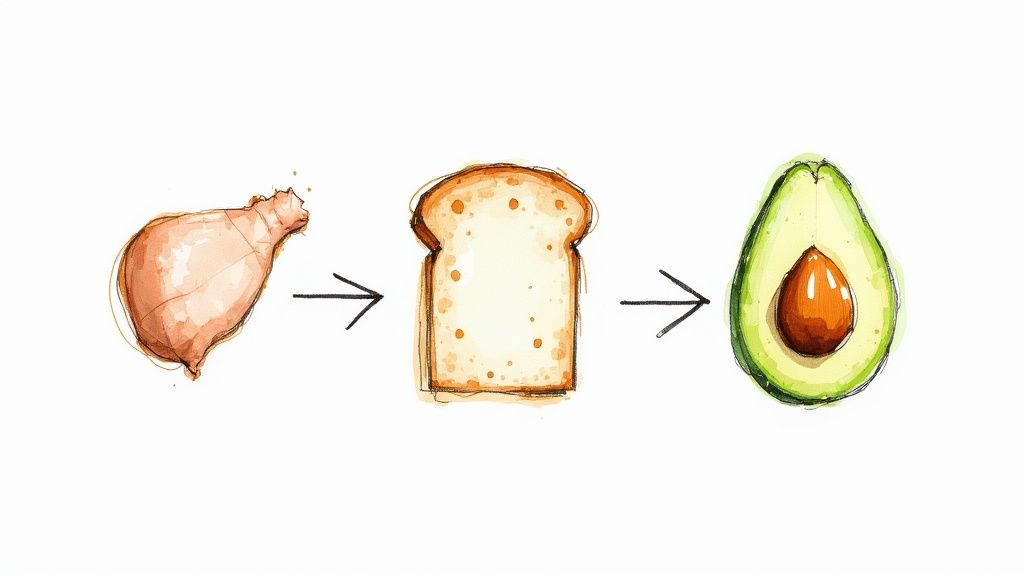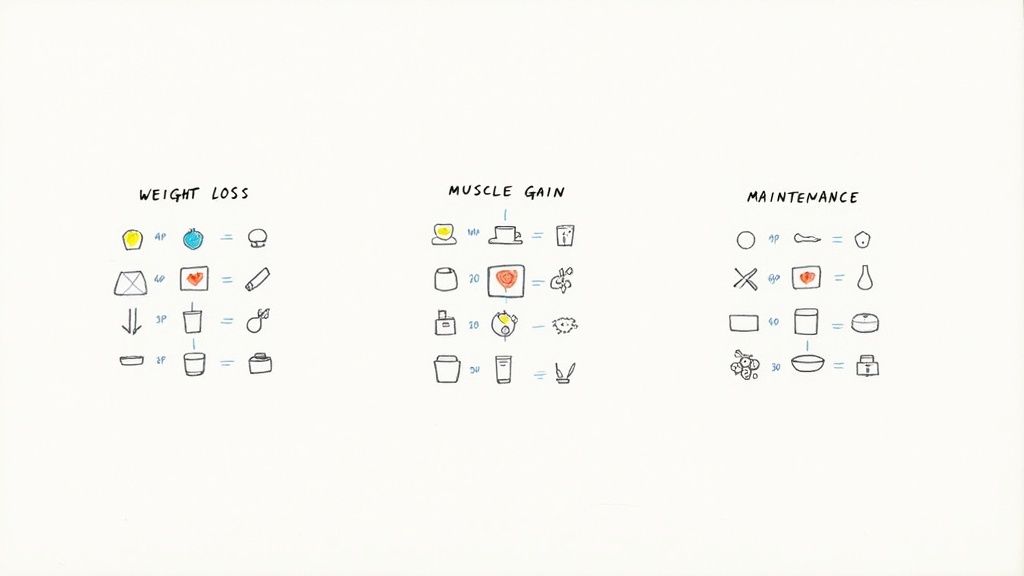Your Guide to Using a Protein Carb Fat Ratio Calculator
Ditch complicated diets. Learn how a protein carb fat ratio calculator can simplify nutrition and help you reach your goals without the stress.
Posted by
Ever feel like you’re eating "healthy" but still feel sluggish or can’t seem to reach your goals? A protein carb fat ratio calculator can be a game-changer. It’s a simple tool that gives you a clear target, like a 40% carb, 30% protein, and 30% fat split, so you can stop guessing and start fueling your body in a way that actually works for you.
What Are Macros and Why Do They Matter?
If you've ever felt like you're eating all the "right" foods but still aren't seeing the results you want, the answer might not be in how much you're eating, but what you're eating. Let's talk about the three main nutrients your body runs on: protein, carbs, and fat—often called "macros."
Think of your body as a busy office. Each macro has a specific job, and for things to run smoothly, everyone needs to show up and do their part. Just counting calories is like knowing the total company budget but not knowing who's on your team. Understanding your macros gives you the full picture.
The A-Team of Your Nutrition
Here’s a simple breakdown of your body's "A-Team" and what each player does:
- Protein (The Repair Crew): This is your builder. Protein is crucial for repairing tissues, building muscle, and it plays a huge role in keeping you feeling full and satisfied after a meal.
- Carbs (The Energy Boosters): These are your body’s favorite, quick-access fuel source. Carbs power your brain and give your muscles the immediate energy they need for everything from a morning walk to focusing on a big project at work.
- Fat (The Long-Haul Fuel): Fat provides slow-burning, long-term energy. It’s also essential for absorbing certain vitamins and supporting hormone production, keeping all the important background systems running as they should.
When you get the balance right, your body has everything it needs to feel its best. Interestingly, studies suggest that protein intake is surprisingly consistent across different populations, which might mean our bodies are naturally pretty good at regulating it. You can learn more about global macronutrient intake trends in this fascinating research.
When you start focusing on the balance of your food, your mindset shifts. It's no longer about restriction, but about mindful nourishment. You're fueling your body with intention, not just filling it up.
Ultimately, using a protein carb fat ratio calculator is just the starting line. The real change happens when you start noticing how these nutrients work together in your meals every day. This approach helps build habits that last, turning nutrition from a chore into a natural, intuitive part of your life.
How To Find Your Ideal Macro Ratio

When it comes to nutrition, there's no magic one-size-fits-all formula. Your ideal ratio of protein, carbs, and fat is totally unique to you. It depends on your goals, your lifestyle, and—most importantly—what you actually enjoy eating.
The best macro split is always the one you can stick with without feeling stressed.
Think about it. A marathon runner needs a ton of carbohydrates for sustained energy. On the flip side, someone focused on building muscle will likely want to dial up their protein. Your day-to-day life matters, too. Someone who works a physically demanding job has different energy needs than a student who spends most of their day at a desk.
Common Starting Points for Different Goals
To get the ball rolling, it helps to look at some common ratios people use as a starting point. These aren't rigid rules, but they are fantastic baselines. From here, you can start experimenting and adjust based on how your body feels.
A popular split for general fat loss is the 40/30/30 ratio. That means 40% of your daily calories come from carbs, 30% from protein, and 30% from fat. The higher protein is great for keeping you full and preserving muscle while you're in a calorie deficit.
Your macro ratio isn't a permanent contract. Think of it as a flexible guide that should evolve as your goals, activity, and energy levels change. The real aim is to find a sustainable balance that makes you feel great, not a rigid plan that adds stress to your life.
For those looking to build muscle, a higher protein intake is key. A common split is 40% protein, 40% carbs, and 20% fat. On the other hand, an endurance athlete might flip that completely, aiming for something closer to 25% protein, 50% carbs, and 25% fat to fuel those long workouts.
Finding a Ratio That Fits Your Lifestyle
Here’s the secret to long-term success: choose a ratio that fits your life, don't try to force your life to fit a ratio. If you genuinely love pasta and bread, a super low-carb diet is probably going to make you miserable, and you'll burn out quickly. The goal is to be mindful, not needlessly restrictive.
Here’s how a few different factors can steer your decision:
- Activity Level: Are you on your feet all day or running every morning? You'll probably feel better with more carbs for energy. If you have a desk job, you might prefer a more balanced split.
- Food Preferences: This is a big one. Pick a ratio that lets you eat the foods you truly enjoy. It makes being consistent feel almost effortless.
- How Your Body Responds: Pay close attention to your energy, hunger, and mood. If you're constantly tired, you might need more carbs. If you're always hungry an hour after eating, a bit more protein or fat could be the answer.
Ultimately, using a protein carb fat ratio calculator is a great way to get a personalized starting point. From there, you can begin tracking and see what feels best for you. If you want to get into the nuts and bolts of the process, our guide on how to count macros has a ton of extra tips.
This whole journey is about listening to your body and making small, sustainable tweaks along the way.
Calculating Your Macros Step by Step
Ready to peek behind the curtain and see how the numbers actually work? While a protein carb fat ratio calculator does all the heavy lifting for you, understanding the process makes the whole concept feel way less intimidating. This isn't about becoming a math whiz; it's about seeing the why behind your targets.
The whole system is built on one simple idea: each macronutrient has a specific energy value. We measure this in calories per gram. It’s pretty straightforward: 4 calories per gram of protein, 4 calories per gram of carbohydrates, and a more dense 9 calories per gram of fat. This is the key that lets us turn a calorie goal into actual grams of food.
The Three-Step Calculation
Let's walk through it with a real-world example. Say your daily target is 2,000 calories, and you’re aiming for a balanced macro split of 30% protein, 40% carbs, and 30% fat.
Figure Out Calories Per Macro: First, you just need to see how your total calories get divided up. Multiply your total calorie goal by the percentage for each macro.
- Protein: 2,000 calories x 0.30 = 600 calories
- Carbohydrates: 2,000 calories x 0.40 = 800 calories
- Fat: 2,000 calories x 0.30 = 600 calories
Convert Calories into Grams: Now for the magic step. We'll turn those calorie amounts into the actual grams you'll be tracking on your plate. This is where those "calories-per-gram" values come into play.
- Protein: 600 calories ÷ 4 calories/gram = 150 grams
- Carbohydrates: 800 calories ÷ 4 calories/gram = 200 grams
- Fat: 600 calories ÷ 9 calories/gram = ~67 grams
And there you have it! Your daily targets are roughly 150g of protein, 200g of carbs, and 67g of fat.
Don't get hung up on hitting these numbers perfectly. Think of them as a daily compass pointing you toward your goals, not a rigid set of rules you can't break. The real aim is awareness and consistency, not perfection.
Visualizing the Macro Calculation Flow
Sometimes, seeing it laid out visually makes it click. This simple chart walks you through the process, from your total calories all the way to your final macro gram targets.

As you can see, once you have your calorie goal and your desired ratio, the rest is just simple arithmetic.
Going through this process manually, even just once, gives you a much deeper appreciation for what's going on with your nutrition. Of course, the point of easy tracking is to avoid doing this math all the time. If you want to get more specific about just your protein intake, you might find our guide on how to calculate your daily protein needs helpful.
Bringing Your Macro Plan to Life

So, you've got your numbers. But what does a 30/40/30 split actually look like on a plate? Knowing your targets is one thing; turning them into breakfast, lunch, and dinner is where the fun begins.
Let's move past the theory. The goal isn't to force a rigid, unfamiliar diet into your life. It's about making small, mindful choices that steer your existing habits in the right direction.
A Day in the Life: Putting Macros Into Practice
Let’s imagine Alex, a busy professional who wants more energy without the headache of a strict diet. After using a protein carb fat ratio calculator, Alex has a daily goal of 1,800 calories, broken down into 30% protein, 40% carbs, and 30% fat.
In real food terms, that looks something like this:
- Protein: 135 grams
- Carbohydrates: 180 grams
- Fat: 60 grams
Now, how does Alex hit these numbers without living in the kitchen or giving up all joy?
Alex’s Simple, Realistic Meal Plan
Alex's day isn't about complex meal prep. It starts simply.
Morning (7 AM): The usual coffee with a splash of oat milk and a banana on the way out the door. It’s a quick-carb start, perfect for that initial burst of energy to get the day rolling.
Lunch (1 PM): To avoid the classic midday slump, Alex swaps a heavy sandwich for a big salad loaded with grilled chicken, chickpeas, and avocado, all tossed in a light vinaigrette. This meal is a fantastic mix of lean protein, healthy fats from the avocado, and fiber-filled carbs from the chickpeas.
Afternoon Snack (4 PM): That 4 p.m. energy dip is real. To fight it off, Alex has a container of Greek yogurt with a handful of berries. It's a simple, protein-packed snack that crushes hunger and keeps focus sharp until dinnertime.
Notice the theme here? It’s not about perfection. It’s about making slightly better choices. The salad offers a much better macro balance than a plain sandwich, and the yogurt provides more lasting energy than a bag of chips.
The Power of Small, Smart Swaps
The real magic is in the tiny adjustments. Alex doesn't have to abandon favorite foods, just make small tweaks that align with those macro goals.
The best nutrition plan is the one that feels effortless enough to become a habit. It’s about finding balance in your real life, not trying to live someone else’s perfect diet.
For example, if Alex is blending a smoothie, throwing in a scoop of protein powder is an easy win. Choosing whole-grain bread over white for toast adds more fiber and complex carbs. These little upgrades are simple to adopt but create a huge impact over time.
This strategy works for all sorts of goals. In one case study, a moderately active woman aiming for weight loss on 1,400 calories a day was advised to hit 155 grams of protein—that’s 44% of her total intake. Her remaining calories were split between carbs and fat, showing how you can structure a high-protein ratio to encourage fat loss. You can dive deeper into how calculating macros supports dietary planning on issaonline.com.
By focusing on these practical, everyday adjustments, Alex can make that macro plan a reality without adding a bunch of stress. It’s all about working smarter, not harder, to give your body the fuel it needs.
The Effortless Way to Track Macros with Munchlog
So, you get what macros are. You’ve seen how to use a protein carb fat ratio calculator, and you even have the know-how to crunch the numbers yourself. But let's be real—who actually wants to pull out a calculator every time they eat? The whole point is to be more in tune with your nutrition, not to turn every meal into a math quiz.
This is where most people get tripped up. It just feels like too much work. But what if tracking was as simple as saying what you ate out loud?
Forget Manual Entry, Say Hello to Voice Logging
Picture this: you finish breakfast and simply say, "I had a coffee with oat milk and a banana." That's it. No fumbling with your phone, no scrolling through massive food databases, no tedious typing.
That’s the magic behind Munchlog. It’s built for real life, where you don’t always have time to stop and meticulously log every ingredient. You just speak, and our AI handles all the complicated stuff, instantly breaking down your meal into its protein, carb, and fat components. For example, just say "I had a bowl of homemade chili for dinner" and Munchlog figures it out for you.
Here’s a look at the clean, simple breakdown Munchlog gives you right after you log a meal.

The app takes your spoken words and translates them into a clear nutritional summary, so you can see exactly how that meal fits into your daily macro targets.
See Your Progress Instantly
Instead of waiting until the end of the day to add everything up, Munchlog provides real-time feedback. Your macro pie chart updates with every entry, helping you make smarter choices for your next meal without the stress.
The goal of tracking isn't to achieve perfection; it's to build awareness. When the process is effortless, you can focus on how your food choices make you feel, not on the chore of logging them.
This immediate visual feedback makes it incredibly easy to see where you stand. Notice you’re a bit low on protein by mid-afternoon? You can consciously reach for a protein-heavy snack. It transforms macro tracking from a rigid, annoying task into a simple, intuitive habit.
This voice-first approach connects all the dots. You have your personal macro targets, and now you have a seamless way to see how your daily food choices stack up. For a deeper dive, check out our guide on how to track macros for more practical tips.
Munchlog is for busy people who want to be more mindful of their nutrition without letting it take over their lives. It's the perfect, stress-free tool for casual tracking.
Common Macro Tracking Questions
Jumping into the world of macros can feel a bit like learning a new language. You’re bound to have questions, and that's a good thing! Let’s walk through some of the most common ones so you can get started with confidence.
Do I Need to Hit My Macro Targets Perfectly Every Day?
Honestly? No. Chasing perfection is a recipe for frustration. Life happens, and your diet should be flexible enough to roll with it.
Think of the numbers from a protein carb fat ratio calculator as a helpful guide, not a rigid set of rules. Some days you'll go over on carbs, other days you might be a little low on fat. That's perfectly okay. What really matters is consistency over perfection. Aiming for a solid weekly average will always beat one "perfect" day followed by giving up.
If you’re not sure where to start, just focus on hitting your protein goal each day. Protein keeps you full and supports muscle, making it a fantastic anchor for your nutrition. Get that right, and the other macros often fall into place.
What Is the Best Protein Carb Fat Ratio for Weight Loss?
This is the million-dollar question, but there’s no single magic answer. The ideal ratio is personal and depends on your activity level, metabolism, and what foods you genuinely enjoy.
That said, a great starting point for many people is a higher protein split. A ratio like 40% protein, 30% carbs, and 30% fat is a popular and effective setup. The extra protein is a powerhouse for satiety—it keeps you feeling full, which helps you naturally eat fewer calories. It also helps protect your muscle when you're in a calorie deficit.
Ultimately, the best ratio is the one you can actually stick to. Try a balanced split, see how your body responds, and don't be afraid to tweak it until you find what works for you.
How Does a Voice Logging App Calculate Macros for Homemade Meals?
This is where technology really shines. Imagine you made a big pot of chili and you tell a voice logging app like Munchlog, "I had a bowl of chili with ground beef, beans, and tomatoes."
Behind the scenes, the AI goes to work. It taps into a massive food database, breaks down your description into its core ingredients, and estimates the amounts. From there, it calculates the total protein, carbs, and fat for your meal.
You can also get more specific by listing the ingredients yourself for even better accuracy. The whole point is to take the tedious task of logging a complex, unmeasured meal and make it as easy as sending a voice note. It removes the friction that causes so many of us to quit tracking in the first place.
Ready to stop guessing and start tracking your macros the easy way? With munchlog.ai, all it takes is your voice. Just speak your meals, and let our AI handle the rest, giving you instant insights without the stress of manual logging. Start your journey toward mindful eating today. Learn more at https://munchlog.ai.